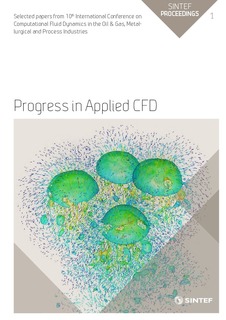| dc.contributor.author | Lalanne, Benjamin | |
| dc.contributor.author | Tanguy, Sebastien | |
| dc.contributor.author | Vejrazka, Jiri | |
| dc.contributor.author | Masbernat, Olivier | |
| dc.contributor.author | Risso, Frederic | |
| dc.date.accessioned | 2017-11-08T06:56:18Z | |
| dc.date.available | 2017-11-08T06:56:18Z | |
| dc.date.issued | 2015 | |
| dc.identifier.isbn | 978-82-536-1433-5 | |
| dc.identifier.isbn | 978-82-536-1432-8 | |
| dc.identifier.issn | 2387-4295 | |
| dc.identifier.uri | http://hdl.handle.net/11250/2464763 | |
| dc.description.abstract | This paper deals with drop and bubble break-up modelling in turbulent flows. We consider the case where the drop/bubble slip velocity is smaller than or of the order of the turbulent velocity scales, or when the drop/bubble deformation is mainly caused by the turbulent stress (atomisation is not addressed here). The deformation of a drop is caused by continuous interactions with turbulent vortices; the drop responds to these interactions by performing shape-oscillations and breaks up when its deformation reaches a critical value. Following these observations, we use a model of forced oscillator that describes the drop deformation dynamics in the flow to predict its break-up probability. Such a model requires a characterization of the shape-oscillation dynamics of the drop. As this dynamics is theoretically known only under restrictive conditions (without gravity, surfactants), CFD two-phase flow simulations, based on the Level-Set and Ghost Fluid methods, are used to determine the interface dynamics in more complex situations: deformation of a drop in the presence of gravity, bubble-vortex interactions. Results are compared with experimental data. The perspectives to apply this model to breakup in emulsification processes are also discussed. | |
| dc.language.iso | eng | |
| dc.publisher | SINTEF Academic Press | |
| dc.relation.ispartof | Selected papers from 10th International Conference on Computational Fluid Dynamics in the Oil & Gas, Metallurgical and Process Industries | |
| dc.relation.ispartofseries | SINTEF Proceedings;1 | |
| dc.subject | Bubble and droplet dynamics | |
| dc.subject | DNS | |
| dc.subject | Breakup modelling | |
| dc.subject | Turbulent flows | |
| dc.subject | Emulsion | |
| dc.title | Drop breakup modelling in turbulent flows | |
| dc.type | Chapter | |
| dc.type | Conference object | |
| dc.type | Peer reviewed | |
| dc.description.version | publishedVersion | |
| dc.rights.holder | © 2015 SINTEF Academic Press | |
| dc.subject.nsi | VDP::Technology: 500 | |
